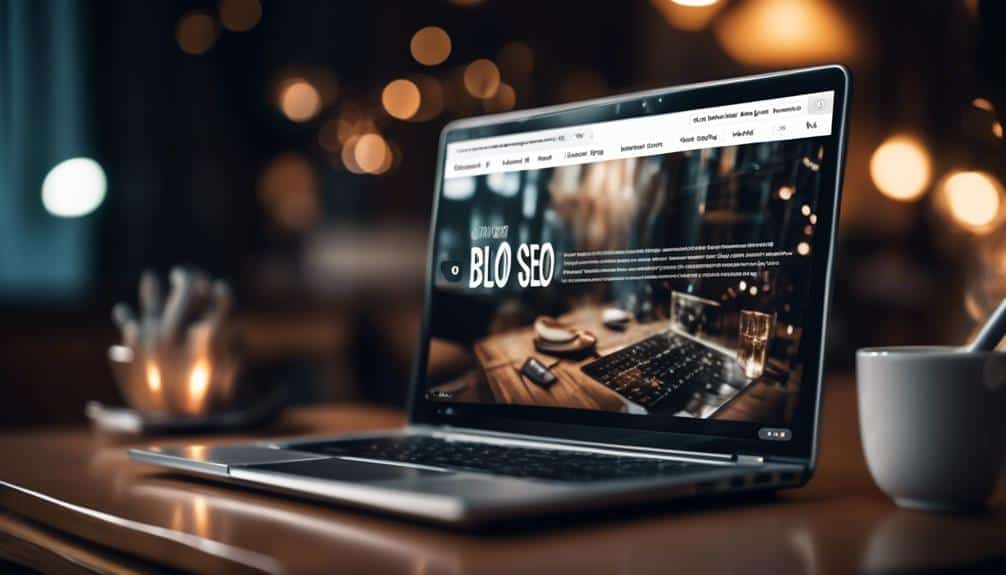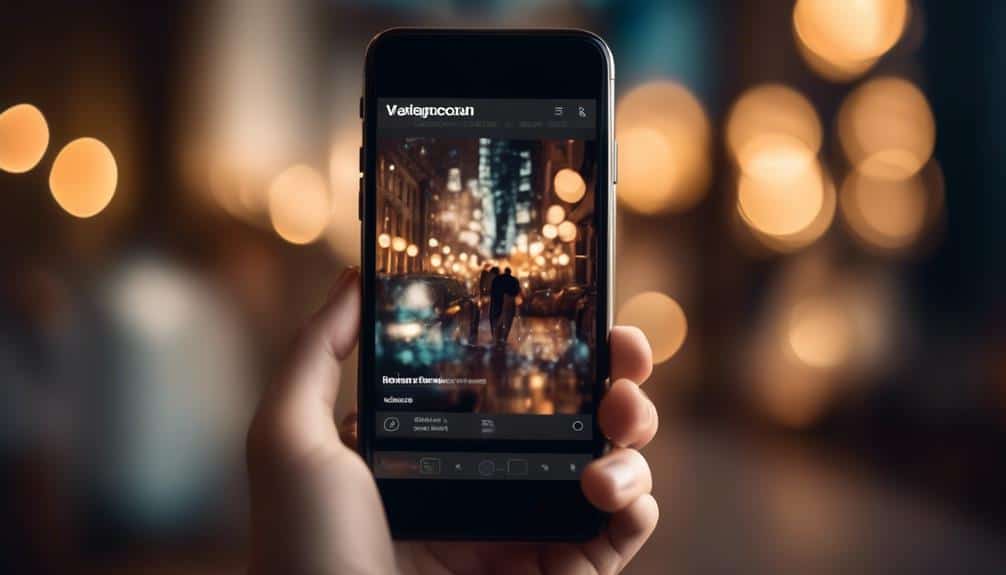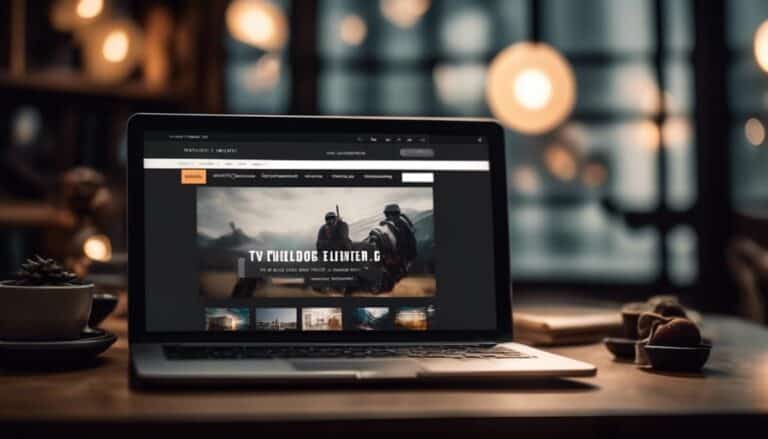On-Page SEO for Bloggers: Optimizing Your Posts for Maximum Impact
When it comes to enhancing the visibility and reach of your blog content, there's a vital component that can significantly elevate your online presence.
By fine-tuning various elements within your blog posts, you can optimize your website for better performance and increased engagement.
As a blogger looking to make a lasting impact in the digital realm, you might be intrigued to discover the subtle yet powerful strategies that can propel your content to new heights.
Stay tuned as we uncover the essential techniques that can transform your posts into powerful assets that resonate with your audience and search engines alike.
Key Takeaways
- Focus on integrating relevant keywords naturally into content for better visibility
- Craft compelling meta descriptions and title tags with strategic keywords to increase CTR
- Enhance content readability by using clear subheadings and visuals for engagement
- Implement technical SEO optimizations such as quality backlinks and image compression for improved rankings
Understanding On-Page SEO Basics

To excel in on-page SEO, grasp the fundamental principles that dictate search engine optimization success for bloggers. Understanding SEO ranking factors is crucial for boosting your content's visibility. Start by focusing on content optimization, which involves creating high-quality, relevant, and engaging posts that resonate with your target audience. Incorporate strategic keywords naturally into your content to improve search engine rankings. Conduct keyword research to identify the terms your audience is searching for and integrate them into your titles, headings, and body text.
Data-driven decisions are key to optimizing your content effectively. Analyze your website's performance using tools like Google Analytics to track visitor behavior and identify opportunities for improvement. By understanding which posts are driving traffic and engagement, you can refine your content strategy to align with what resonates most with your audience.
Stay ahead of the curve by staying informed about the latest SEO trends and best practices. Implementing a strategic approach to content optimization based on SEO ranking factors will help you attract more organic traffic and grow your blog's reach.
Crafting Compelling Meta Descriptions
Craft a compelling meta description that entices users to click through to your blog by incorporating strategic keywords and highlighting the unique value your content offers. Crafting engaging copy and increasing CTR with meta descriptions go hand in hand. Your meta description is your blog post's first impression in search engine results, so make it count. Use relevant keywords that align with users' search intent and showcase what sets your content apart. Below is a table to guide you in creating effective meta descriptions:
| Focus on Value | Incorporate Keywords | Call to Action |
|---|---|---|
| Solve a problem or offer a benefit in a concise manner. | Include target keywords naturally to improve visibility. | Prompt users to take action like "Learn more" or "Discover now". |
Crafting compelling meta descriptions is a strategic way to drive organic traffic to your blog. By following these guidelines, you can increase your click-through rate and attract more visitors interested in your unique content.
Leveraging Strategic Keyword Placement

To optimize your blog for search engines effectively, you must strategically place keywords in key areas of your content. By selecting targeted keywords relevant to your niche, you can enhance the visibility of your blog posts.
Ensure that your content is optimized with SEO-friendly practices to boost your rankings and attract organic traffic.
Key Placement Techniques
Strategically placing keywords throughout your blog content can significantly impact your on-page SEO performance. To enhance your SEO strategy and boost visibility, consider the following key placement techniques:
- Utilize Keywords in Headings: Incorporate your researched keywords into your blog post headings to signal their importance to search engines.
- Sprinkle Keywords Naturally: Integrate keywords organically throughout your content to maintain readability and relevance.
- Optimize Meta Descriptions: Craft compelling meta descriptions that include relevant keywords to improve click-through rates and attract more visitors.
Targeted Keyword Selection
When selecting keywords for your blog content, focus on strategic placement to maximize SEO impact and attract targeted traffic. Start by conducting thorough keyword research and competitor analysis to identify the most relevant terms for your niche.
Stay updated on current SEO trends and algorithm updates to ensure your keywords align with search engine preferences. Incorporating these insights into your content will help you rank higher in search results and reach your desired audience effectively.
SEO-Friendly Content Optimization
For optimal SEO results in your blog content, ensure strategic placement of keywords plays a central role in maximizing visibility and attracting targeted traffic. To enhance your content for better search engine visibility and user engagement, consider the following key strategies:
- Strategic Keyword Placement: Integrate relevant keywords naturally throughout your content to signal search engines about the topic and intent of your post.
- Semantic Keyword Variation: Use related terms and synonyms to provide context and depth to your content, enhancing user experience.
- Keyword Density: Maintain an appropriate keyword density to strike a balance between SEO optimization and readability, ensuring your content remains engaging and informative.
Optimizing Title Tags for Click-Throughs

To enhance your blog's visibility and attract more clicks, focus on crafting compelling title tags that resonate with your target audience's search intent. Title length plays a crucial role in click-through rates. Aim for titles that are around 50-60 characters to ensure they display properly in search results and entice users to click. Additionally, incorporate relevant keywords at the beginning of your title to grab the reader's attention and improve SEO.
When optimizing title tags for click-throughs, consider using power words that evoke curiosity, urgency, or emotion. These words can pique the interest of your audience and compel them to click on your blog post. Analyze data from your analytics tools to track the performance of different title tag variations. Experiment with A/B testing to see which titles drive higher click-through rates and adjust your strategy accordingly.
Enhancing Content Readability and Structure
Crafting compelling title tags is just the beginning; now focus on enhancing the readability and structure of your content to keep your audience engaged and improve SEO performance. To improve engagement and enhance user experience, consider the following strategies:
- Utilize Subheadings: Break down your content into clear sections with descriptive subheadings. This not only makes your content easier to scan but also helps readers navigate through the information more efficiently.
- Use Bullet Points and Numbered Lists: Organize information using bullet points or numbered lists. This formatting technique not only enhances readability but also helps readers grasp key points quickly.
- Incorporate Visuals: Enhance your content with relevant images, infographics, or videos. Visual elements not only break up text but also make your content more engaging and appealing to your audience.
Utilizing Internal and External Links

When optimizing your blog for search engines, it's crucial to understand the impact of internal and external links. Utilize a strategic anchor text strategy to enhance the relevance and authority of your content.
Linking for SEO
Implementing a well-planned linking strategy can significantly boost your blog's SEO performance and enhance your website's overall visibility. When it comes to linking for SEO, here are three essential tactics to consider:
- Utilize Internal Links: Link relevant articles within your blog to improve navigation and increase the time visitors spend on your site.
- Opt for Quality Backlinks: Focus on obtaining backlinks from authoritative websites in your niche to enhance your site's credibility and ranking.
- Conduct Regular Backlink Analysis: Use tools to monitor your backlink profile, identify low-quality links, and disavow them to maintain a strong link profile.
Anchor Text Strategy
To optimize your on-page SEO effectively, masterfully selecting anchor text for both internal and external links is paramount. When crafting anchor text, consider using a mix of keywords and natural language to enhance link diversity.
Incorporating variations in your anchor text helps search engines understand the context of your content and boosts your SEO efforts. For internal links, utilize descriptive anchor text that provides insight into the linked page's topic.
When it comes to external links, focus on creating a seamless user experience by ensuring the anchor text is relevant to the destination. By implementing natural link building and optimization techniques, you can enhance the credibility and visibility of your blog while improving your overall SEO strategy.
Incorporating Image Optimization Techniques
Maximize your blog's visibility and engagement by applying effective image optimization techniques. Enhancing your images not only improves user experience but also boosts your SEO efforts. Here are some key strategies to incorporate:
- Image compression strategies: Reduce image file sizes without compromising quality to ensure faster loading times, which is crucial for user retention and SEO rankings.
- Alt text optimization: Craft descriptive alt text for your images to improve accessibility and provide search engines with context about the image, helping with SEO and ensuring visually impaired users can understand the content.
- Visual storytelling: Use images to complement your content and tell a visual story that engages your audience. Visuals can evoke emotions, enhance understanding, and make your blog more memorable.
Implementing Mobile-Friendly Design Elements

Enhancing your blog's user experience and SEO performance through effective image optimization techniques sets the stage for incorporating mobile-friendly design elements seamlessly. When it comes to optimizing your blog for mobile devices, responsive design is key. Ensuring that your blog adapts to different screen sizes and resolutions is crucial for providing a smooth user experience on mobile.
Implementing mobile-friendly design elements not only enhances user experience but also plays a significant role in improving your site's SEO performance. Search engines like Google prioritize mobile-friendly websites in their search results, making it essential to prioritize mobile optimization.
Mobile-Friendly Design Elements
| Feature | Description | Benefit |
|---|---|---|
| Responsive Layout | Adapts to various screen sizes | Improved user experience |
| Mobile-Friendly Menus | Easy navigation on small screens | Better engagement |
| Fast Loading Speed | Quick loading times for mobile users | Reduced bounce rates |
| Touchscreen Support | Optimized for touch interactions | Enhanced usability |
Analyzing and Improving Page Loading Speed
Improving page loading speed is a critical factor in optimizing your blog for both user experience and search engine performance. To enhance your site's speed and overall performance, consider the following strategies:
- Improving caching techniques: Utilize browser caching to store frequently accessed resources locally, reducing the need for repeated downloads and speeding up load times.
- Minimizing render blocking resources: Identify and address any CSS or JavaScript files that may be preventing your page from loading smoothly. Prioritize critical resources to allow for faster rendering.
- Optimizing image sizes: Compress images without compromising quality to reduce file sizes and decrease loading times, enhancing both user experience and SEO rankings.
Frequently Asked Questions
How Can Bloggers Effectively Incorporate Long-Tail Keywords Into Their On-Page SEO Strategy?
Want to boost your SEO game? Start by conducting keyword research and analyzing your competition. Then, strategically incorporate long-tail keywords into your content structure and formatting. This approach maximizes impact and drives organic traffic.
What Are Some Advanced On-Page SEO Techniques That Bloggers Can Use to Further Optimize Their Posts?
Enhance your blog's impact with advanced techniques. Optimize images for speed and engagement. Boost SEO with strategic internal linking. Prioritize mobile responsiveness for user experience. Innovate your posts for maximum results.
How Can Bloggers Measure the Success of Their On-Page SEO Efforts and Track Improvements Over Time?
To measure success and track progress, focus on conversion tracking and performance metrics. Monitor user engagement and click-through rates to gauge the impact of your on-page SEO efforts. Use data-driven insights for continuous improvement.
Are There Any Specific On-Page SEO Tools or Plugins That Bloggers Can Use to Streamline Their Optimization Process?
When diving into on-page SEO, you'll find tools like SEMrush for detailed SEO analysis and Yoast SEO plugin for content optimization. These resources streamline your optimization process, providing insights and suggestions for better performance.
How Important Is Social Media Integration in Relation to On-Page SEO for Bloggers, and What Are Some Best Practices for Utilizing Social Platforms to Enhance SEO Impact?
To maximize SEO impact, integrate social media seamlessly. Engage with your audience, encourage content sharing, and boost search rankings. Leverage social platforms strategically for increased visibility and traffic. Stay ahead with social engagement strategies for optimal results.
Conclusion
In conclusion, mastering on-page SEO is crucial for bloggers looking to maximize their impact online.
By strategically optimizing your meta descriptions, keywords, title tags, content structure, links, images, and mobile design, you can increase visibility and engagement on search engines.
Analyzing page loading speed is also important for user experience and search rankings.
Keep refining your on-page SEO strategy with data-driven insights to stay ahead of the competition and drive more traffic to your blog.








